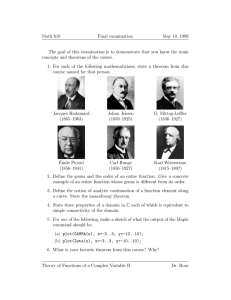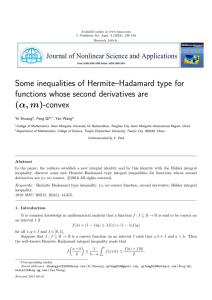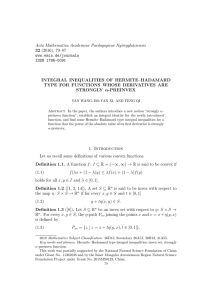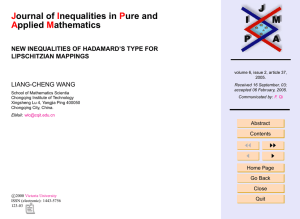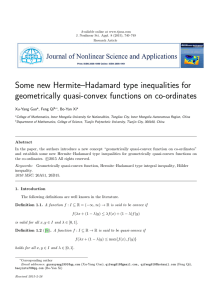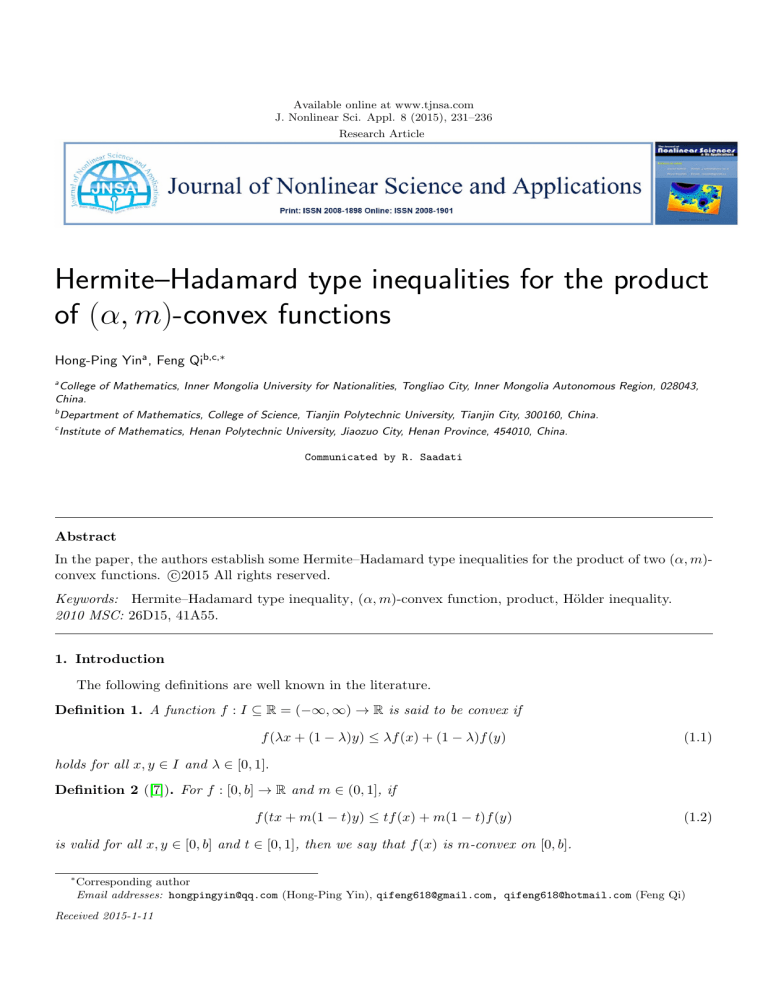
Available online at www.tjnsa.com
J. Nonlinear Sci. Appl. 8 (2015), 231–236
Research Article
Hermite–Hadamard type inequalities for the product
of (α, m)-convex functions
Hong-Ping Yina , Feng Qib,c,∗
a
College of Mathematics, Inner Mongolia University for Nationalities, Tongliao City, Inner Mongolia Autonomous Region, 028043,
China.
b
Department of Mathematics, College of Science, Tianjin Polytechnic University, Tianjin City, 300160, China.
c
Institute of Mathematics, Henan Polytechnic University, Jiaozuo City, Henan Province, 454010, China.
Communicated by R. Saadati
Abstract
In the paper, the authors establish some Hermite–Hadamard type inequalities for the product of two (α, m)convex functions. c 2015 All rights reserved.
Keywords: Hermite–Hadamard type inequality, (α, m)-convex function, product, Hölder inequality.
2010 MSC: 26D15, 41A55.
1. Introduction
The following definitions are well known in the literature.
Definition 1. A function f : I ⊆ R = (−∞, ∞) → R is said to be convex if
f (λx + (1 − λ)y) ≤ λf (x) + (1 − λ)f (y)
(1.1)
holds for all x, y ∈ I and λ ∈ [0, 1].
Definition 2 ([7]). For f : [0, b] → R and m ∈ (0, 1], if
f (tx + m(1 − t)y) ≤ tf (x) + m(1 − t)f (y)
(1.2)
is valid for all x, y ∈ [0, b] and t ∈ [0, 1], then we say that f (x) is m-convex on [0, b].
∗
Corresponding author
Email addresses: hongpingyin@qq.com (Hong-Ping Yin), qifeng618@gmail.com, qifeng618@hotmail.com (Feng Qi)
Received 2015-1-11
H.-P. Yin, F. Qi, J. Nonlinear Sci. Appl. 8 (2015), 231–236
232
Definition 3 ([4]). For f : [0, b] → R and (α, m) ∈ (0, 1] × (0, 1], if
f (tx + m(1 − t)y) ≤ tα f (x) + m(1 − tα )f (y)
(1.3)
is valid for all x, y ∈ [0, b] and t ∈ [0, 1], then we say that f (x) is (α, m)-convex on [0, b].
In recent decades, many inequalities of the Hermite–Hadamard type for various kinds of convex functions
have been established. Some of them may be recited as follows.
Theorem 1.1 ([3]). Let f : [a, b] ⊆ R0 = [0, ∞) → R be m-convex for fixed m ∈ (0, 1]. Then
Z b
1
f (a) + mf (b/m) mf (a/m) + f (b)
f (x) d x ≤ min
.
,
b−a a
2
2
Theorem 1.2 ([5]). Let f, g : [a, b] ⊆ R → R0 be convex functions. Then
Z b
1
1
1
f (x)g(x) d x ≤ M (a, b) + N (a, b),
b−a a
3
6
(1.4)
(1.5)
where M (a, b) = f (a)g(a) + f (b)g(b) and N (a, b) = f (a)g(b) + f (b)g(a).
Theorem 1.3 ([2]). Let f, g : R0 → R0 satisfy f g ∈ L([a, b]), where 0 ≤ a < b < ∞. If f is m1 -convex and
g is m2 -convex on [a, b] for some fixed m1 , m2 ∈ (0, 1], then
Z b
1
f (x)g(x) d x ≤ min{M1 , M2 },
(1.6)
b−a a
where
M1 =
and
1
b
b
b
1
b
f (a)g(a) + m1 m2 f
g
+ m2 f (a)g
+ m1 f
g(a)
3
m1
m2
6
m2
m1
a
a
a
1
a
1
f (b)g(b) + m1 m2 f
g
+ m1 f
g(b) + m2 f (b)g
.
M2 =
3
m1
m2
6
m1
m2
Theorem 1.4 ([2]). Let f, g : R0 → R0 satisfy f g ∈ L([a, b]) with 0 ≤ a < b < ∞. If f is (α1 , m1 )-convex
and g is (α2 , m2 )-convex on [a, b] for (α1 , m1 ), (α2 , m2 ) ∈ (0, 1] × (0, 1], then
Z b
1
f (x)g(x) d x ≤ min{N1 , N2 },
(1.7)
b−a a
where
f (a)g(a)
1
1
b
1
+ m2
−
f (a)g
− m1
N1 =
α1 + α2 + 1
α1 + 1 α1 + α2 + 1
m2
α1 + α2 + 1
1
b
1
1
1
b
b
−
g(a)f
+ m1 m2 1 −
−
+
f
g
α2 + 1
m1
α1 + 1 α2 + 1 α1 + α2 + 1
m1
m2
and
f (b)g(b)
1
1
a
1
N2 =
+ m2
−
f (b)g
− m1
α1 + α2 + 1
α1 + 1 α1 + α2 + 1
m2
α1 + α2 + 1
1
a
1
1
1
a
a
−
g(b)f
+ m1 m2 1 −
−
+
f
g
.
α2 + 1
m1
α1 + 1 α2 + 1 α1 + α2 + 1
m1
m2
In recent years, some inequalities of the Hermite–Hadamard type for other kinds of convex functions
were created in, for example, [1, 6, 8, 9, 10, 11, 12] and closely related references therein.
The aim of this paper is to present some new inequalities of the Hermite–Hadamard type for the product
of two (α, m)-convex functions, which generalizes those results mentioned above.
H.-P. Yin, F. Qi, J. Nonlinear Sci. Appl. 8 (2015), 231–236
233
2. Main results
We are now in a position to establish some new integral inequalities of the Hermite–Hadamard type for
the product of two (α, m)-convex functions.
Theorem 2.1. Let f, g :R0 → R0 satisfy f, f g q ∈ L([a,
b]), where 0 ≤ a < b < ∞ and q ≥ 1. If f is
(α1 , m1 )-convex on 0, mb1 and g q is (α2 , m2 )-convex on 0, mb2 for (α1 , m1 ), (α2 , m2 ) ∈ (0, 1] × (0, 1], then
1
b−a
Z
a
b
[N (a, b; f, α1 , m1 )]1−1/q min [M (a, b; f, g q )]1/q , [M (b, a; f, g q )]1/q
f (x)g(x) d x ≤
,
(α1 + 1)[(α2 + 1)(α1 + α2 + 1)]1/q
where
b
N (a, b; f, α, m) = f (a) + αmf
m
(2.1)
and
b
M (a, b; f, g) = (α1 + 1)(α2 + 1)f (a)g(a) + α2 m2 (α2 + 1)f (a)g
m2
b
b
b
+ α1 α2 (α1 + α2 + 2)m1 m2 f
g
. (2.2)
+ α1 m1 (α1 + 1)g(a)f
m1
m1
m2
Proof. Letting x = ta + (1 − t)b for t ∈ [0, 1] and making use of the Hölder integral inequality yield
1
b−a
Z
b
Z
a
1
f (ta + (1 − t)b)g(ta + (1 − t)b) d t
f (x)g(x) d x =
0
Z
≤
1
1−1/q Z
f (ta + (1 − t)b) d t
0
1
1/q
f (ta + (1 − t)b)g (ta + (1 − t)b) d t
.
q
0
Further employing the conditions that f is (α1 , m1 )-convex on 0, mb1 and g q is (α2 , m2 )-convex on 0, mb2
leads to
Z 1
Z 1
1
b
α1
α1
dt =
N (a, b; f, α1 , m1 )
f (ta + (1 − t)b) d t ≤
t f (a) + m1 (1 − t )f
m
α
1
1+1
0
0
and
Z
1
f (ta + (1 − t)b)g q (ta + (1 − t)b) d t
0
Z 1
b
b
α1
α1
α2 q
α2 q
≤
t f (a) + m1 (1 − t )f
t g (a) + m2 (1 − t )g
dt
m1
m2
0
1
α2 m2
b
q
q
=
f (a)g (a) +
f (a)g
α1 + α2 + 1
(α1 + 1)(α1 + α2 + 1)
m2
α1 m1
b
α1 α2 (α1 + α2 + 2)m1 m2
b
b
q
q
+
f
g (a) +
f
g
(α2 + 1)(α1 + α2 + 1)
m1
(α1 + 1)(α2 + 1)(α1 + α2 + 1)
m1
m2
1
M (a, b; f, g q ).
=
(α1 + 1)(α2 + 1)(α1 + α2 + 1)
The proof of Theorem 2.1 is complete.
Remark 4. Theorem 2.1 applied to q = 1 becomes the inequality (1.7).
Corollary 5. Under the conditions of Theorem 2.1,
H.-P. Yin, F. Qi, J. Nonlinear Sci. Appl. 8 (2015), 231–236
234
1. if α1 = α2 = α, we have
1
b−a
b
Z
a
[N (a, b; f, α, m1 )]1−1/q min [M (a, b; f, g q )]1/q , [M (b, a; f, g q )]1/q
f (x)g(x) d x ≤
;
(α + 1)1+1/q (2α + 1)1/q
2. if m1 = m2 = m, we have
1
b−a
Z
a
b
[N (a, b; f, α1 , m)]1−1/q min [M (a, b; f, g q )]1/q , [M (b, a; f, g q )]1/q
f (x)g(x) d x ≤
;
(α1 + 1)[(α2 + 1)(α1 + α2 + 1)]1/q
3. if α1 = α2 = m1 = m2 = 1, we have
1
b−a
Z
b
a
1 1 1/q
f (x)g(x) d x ≤
[f (a) + f (b)]1−1/q
2 3
1/q
× 2f (a)g q (a) + f (a)g q (b) + f (b)g q (a) + 2f (b)g q (b)
.
q
Theorem 2.2. Let f,g : R0 → R0 be such that f q , g q/(q−1) ∈ L([a,
b]),
where 0 ≤ a < b < ∞ and q > 1. If f
b
b
q/(q−1)
is (α2 , m2 )-convex on 0, m2 for (α1 , m1 ), (α2 , m2 ) ∈ (0, 1]×(0, 1],
is (α1 , m1 )-convex on 0, m1 and g
then
1
b−a
Z
b
a
min{N (a, b; f q , α1 , m1 ), N (b, a; f q , α1 , m1 )} 1/q
f (x)g(x) d x ≤
α1 + 1
min{N (a, b; g q/(q−1) , α2 , m2 ), N (b, a; g q/(q−1) , α2 , m2 )} 1−1/q
×
, (2.3)
α2 + 1
where N (a, b; f, α, m) is defined by (2.1).
Proof. Taking x = ta + (1 − t)b for t ∈ [0, 1] and using the Hölder integral inequality generate
1
b−a
Z
b
Z
a
1
f (ta + (1 − t)b)g(ta + (1 − t)b) d t
f (x)g(x) d x =
0
Z
≤
0
1
1/q Z
f q (ta + (1 − t)b) d t
1
1−1/q
g q/(q−1) (ta + (1 − t)b) d t
.
0
Utilizing properties that f q is (α1 , m1 )-convex on 0, mb1 and that g q/(q−1) is (α2 , m2 )-convex on 0, mb2
discovers
Z 1
Z 1
b
1
q
α1 q
α1 q
f (ta + (1 − t)b) d t ≤
t f (a) + m1 (1 − t )f
dt =
N (a, b; f q , α1 , m1 ).
m
α
+
1
1
1
0
0
Considering the symmetry of the estimated definite integral with respect to a and b results in
Z 1
min{N (a, b; f q , α1 , m1 ), N (b, a; f q , α1 , m1 )}
f q (ta + (1 − t)b) d t ≤
.
α1 + 1
0
Similarly, we have
Z
1
g
0
q/(q−1)
min N (a, b; g q/(q−1) , α2 , m2 ), N (b, a; g q/(q−1) , α2 , m2
(ta + (1 − t)b) d t ≤
.
α2 + 1
Theorem 2.2 is thus proved.
H.-P. Yin, F. Qi, J. Nonlinear Sci. Appl. 8 (2015), 231–236
235
Corollary 6. Under the conditions of Theorem 2.2, if α1 = α2 = m1 = m2 = 1, then
1−1/q
Z b
[f q (a) + f q (b)]1/q g q/(q−1) (a) + g q/(q−1) (b)
1
f (x)g(x) d x ≤
.
b−a a
2
(2.4)
Theorem 2.3. Let f, g : R0 → R0 be such that f p g q−`(q−1) , f (q−p)/(q−1) g ` ∈ L([a, b]), where
0 ≤ a < b < ∞,
q
q > 1, q > p > 0, and q−1
> ` > 0. If f p and f (q−p)/(q−1) are (α1 , m1 )-convex on 0, mb1 and if g ` and
g q−`/(q−1) are (α2 , m2 )-convex on 0, mb2 for (α1 , m1 ), (α2 , m2 ) ∈ (0, 1] × (0, 1], then
1
b−a
Z
b
1
min M a, b; f p , g q−`(q−1) ,
(α1 + 1)(α2 + 1)(α1 + α2 + 1)
1/q 1−1/q
p q−`(q−1)
M b, a; f , g
min M a, b; f (q−p)/(q−1) , g ` , M b, a; f (q−p)/(q−1) , g `
,
f (x)g(x) d x ≤
a
where M (a, b; f, g) is defined by (2.2).
Proof. Letting x = ta + (1 − t)b for t ∈ [0, 1] and using the Hölder integral inequality figure out
Z 1
Z b
1
f (ta + (1 − t)b)g(ta + (1 − t)b) d t
f (x)g(x) d x =
b−a a
0
Z 1
1/q
p
q−`(q−1)
≤
f (ta + (1 − t)b)g
(ta + (1 − t)b) d t
0
Z
×
1
f
(q−p)/(q−1)
1−1/q
(ta + (1 − t)b)g (ta + (1 − t)b) d t
.
`
0
Further by virtue of properties that the function f p is (α1 , m1 )-convex on 0, mb1 and that the function
g q−`/(q−1) is (α2 , m2 )-convex on 0, mb2 , we have
Z 1
f p (ta + (1 − t)b)g q−`(q−1) (ta + (1 − t)b) d t
0
Z 1
b
b
α1 p
α1 p
α2 q−`(q−1)
α2 q−`(q−1)
t f (a) + m1 (1 − t )f
t g
(a) + m2 (1 − t )g
dt
≤
m1
m2
0
1
α2 m2
b
p
q−`(q−1)
p
q−`(q−1)
=
f (a)g
(a) +
f (a)g
α1 + α2 + 1
(α1 + 1)(α1 + α2 + 1)
m2
α1 m1
b
+
fp
g q−`(q−1) (a)
(α2 + 1)(α1 + α2 + 1)
m1
α1 α2 (α1 + α2 + 2)m1 m2
b
b
p
q−`(q−1)
+
f
g
(α1 + 1)(α2 + 1)(α1 + α2 + 1)
m1
m2
1
M a, b; f p , g q−`(q−1) .
=
(α1 + 1)(α2 + 1)(α1 + α2 + 1)
Changing the order of a and b in the above arguments reveals
Z 1
min M a, b; f p , g q−`(q−1) , M b, a; f p , g q−`(q−1)
p
q−`(q−1)
f (ta + (1 − t)b)g
(ta + (1 − t)b) d t ≤
(α1 + 1)(α2 + 1)(α1 + α2 + 1)
0
and
Z
1
f (q−p)/(q−1) (ta + (1 − t)b)g ` (ta + (1 − t)b) d t
0
min M a, b; f (q−p)/(q−1) , g ` , M b, a; f (q−p)/(q−1) , g `
≤
.
(α1 + 1)(α2 + 1)(α1 + α2 + 1)
The proof of Theorem 2.3 is complete.
H.-P. Yin, F. Qi, J. Nonlinear Sci. Appl. 8 (2015), 231–236
236
q
Corollary 7. Under the conditions of Theorem 2.3, if p = ` ≤ min q, q−1
, then we have
1
b−a
Z
b
1
min M a, b; f p , g q−p(q−1) ,
(α1 + 1)(α2 + 1)(α1 + α2 + 1)
1/q 1−1/q
p q−p(q−1)
M b, a; f , g
min M a, b; f (q−p)/(q−1) , g p , M b, a; f (q−p)/(q−1) , g p
.
f (x)g(x) d x ≤
a
Corollary 8. Under the conditions of Theorem 2.3, when α1 = α2 = m1 = m2 = 1, we have
1
b−a
Z
b
1 p
2f (a)g q−`(q−1) (a) + f p (a)g q−`(q−1) (b)
6
1/q (q−p)/(q−1)
+ f p (b)g q−`(q−1) (a) + 2f p (b)g q−`(q−1) (b)
2f
(a)g ` (a)
f (x)g(x) d x ≤
a
1−1/q
+ f (q−p)/(q−1) (a)g ` (b) + f (q−p)/(q−1) (b)g ` (a) + 2f (q−p)/(q−1) (b)g ` (b)
.
Acknowledgements
This work was partially supported by the Science Research Funding of the Inner Mongolia University for
Nationalities in China under Grant No. NMD1301, by the NNSF of China under Grant No. 11361038, and
by the Foundation of the Research Program of Science and Technology at Universities of Inner Mongolia
Autonomous Region in China under Grant No. NJZY14191.
References
[1] R.-F. Bai, F. Qi, B.-Y. Xi, Hermite-Hadamard type inequalities for the m- and (α, m)-logarithmically convex functions,
Filomat, 27 (2013), 1–7.
[2] M. K. Bakula, M. E. Özdemir, J. Pečarić, Hadamard type inequalities for m-convex and (α, m)-convex functions, JIPAM,
J. Inequal. Pure Appl. Math., 9 (2008), 12 pages.
[3] S. S. Dragomir, G. Toader, Some inequalities for m-convex functions, Studia Univ. Babeş-Bolyai Math. 38 (1993), 21–28.
[4] V. G. Miheşan, A generalization of the convexity, Seminar on Functional Equations, Approx. Convex, Cluj-Napoca, (1993).
[5] B. G. Pachpatte, On some inequalities for convex functions, RGMIA Res. Rep. Coll. 6 (2003), Suppl., Art. 1; Available
online at http://rgmia.org/v6(E).php.
[6] Y. Shuang, H.-P. Yin, F. Qi, Hermite-Hadamard type integral inequalities for geometric-arithmetically s-convex functions,
Analysis (Munich), 33 (2013), 197–208.
[7] G. Toader, Some generalizations of the convexity, Proceedings of the Colloquium on Approximation and Optimization,
Univ. Cluj-Napoca, Cluj, (1985), 329–338.
[8] B.-Y. Xi, F. Qi, Hermite-Hadamard type inequalities for functions whose derivatives are of convexities, Nonlinear Funct.
Anal. Appl., 18 (2013), 163–176.
[9] B.-Y. Xi, F. Qi, Some Hermite-Hadamard type inequalities for differentiable convex functions and applications, Hacet. J.
Math. Stat., 42 (2013), 243–257.
[10] B.-Y. Xi, F. Qi, Some inequalities of Hermite-Hadamard type for h-convex functions, Adv. Inequal. Appl., 2 (2013), 1–15.
[11] B.-Y. Xi, Y. Wang, F. Qi, Some integral inequalities of Hermite-Hadamard type for extended (s, m)-convex functions,
Transylv. J. Math. Mechanics, 5 (2013), 69–84.
[12] T.-Y. Zhang, A.-P. Ji, F. Qi, Some inequalities of Hermite-Hadamard type for GA-convex functions with applications to
means, Matematiche (Catania) 68 (2013), 229–239.




